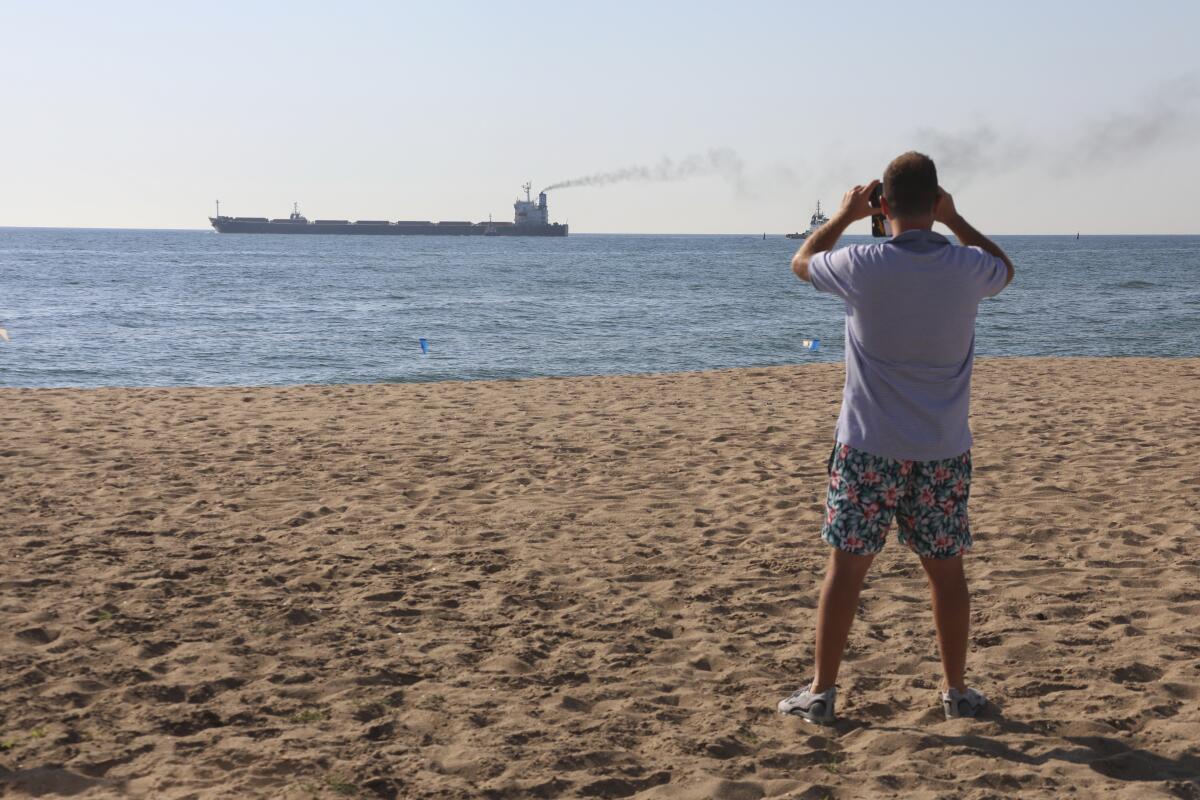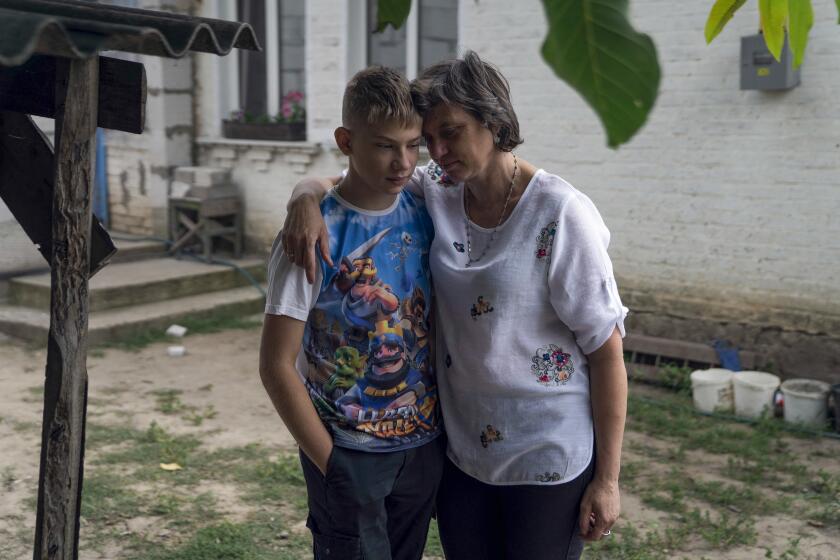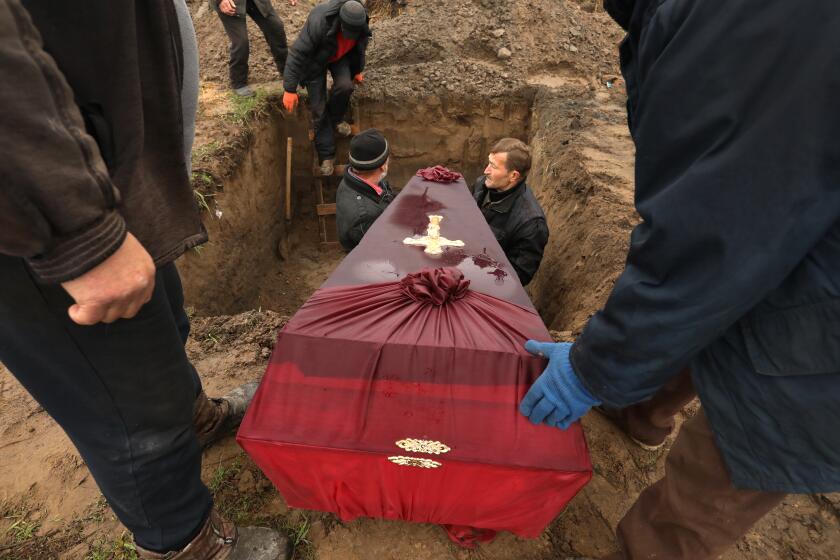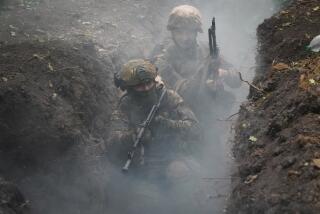Shift in war’s front seen as more ships with grain are cleared to leave Ukraine

- Share via
KYIV, Ukraine — Six more ships carrying agricultural cargo held up by the war in Ukraine received authorization Sunday to leave the country’s Black Sea coast as analysts warned that Russia was moving troops and equipment in the direction of the southern port cities to stave off a Ukrainian counteroffensive.
Ukraine and Russia also accused each other of shelling Europe’s largest nuclear power plant.
The loaded vessels were cleared to depart from Chornomorsk and Odesa, according to the Joint Coordination Center, which oversees an international deal intended to get some 20 million tons of grain out of Ukraine to feed millions going hungry in Africa, the Middle East and parts of Asia.
Tymophiy, 12, lost his mother and stepfather in a hail of Russian fire and is now in the care of relatives. His diary is a record of fury and grief.
Ukraine, Russia, Turkey and the United Nations signed the agreements last month to create a 111-nautical-mile sea corridor that would allow cargo ships to travel safely out of ports that Russia’s military had blockaded and through waters that Ukraine’s military had mined. Implementation of the deal, which is in effect for four months, has proceeded slowly since the first ship embarked on Aug. 1.
Four of the carriers cleared Sunday to leave Ukraine were transporting more than 219,000 tons of corn. The fifth was carrying more than 6,600 tons of sunflower oil and the sixth 11,000 tons of soya, the Joint Coordination Center said.
Three other cargo ships that left Friday passed their inspections and received clearance Sunday to pass through Turkey’s Bosporus Strait on the way to their final destinations, the Center said.
However, the vessel that left Ukraine last Monday with great fanfare as the first under the grain exports deal had its scheduled arrival in Lebanon delayed Sunday, according to a Lebanese Cabinet minister and the Ukraine Embassy. The cause of the delay was not immediately clear.
Ukrainian officials were initially skeptical of a grain export deal, citing suspicions that Moscow would try to exploit shipping activity to mass troops offshore or send long-range missiles from the Black Sea, as it has done multiple times during the war.
The agreements call for ships to leave Ukraine under military escort and to undergo inspections to make sure they carry only grain, fertilizer or food and not any other commodities. Inbound cargo vessels are checked to ensure they are not carrying weapons.
In a weekend analysis, Britain’s Defense Ministry said the Russian invasion that started Feb. 24 “is about to enter a new phase” in which the fighting would shift to a roughly 217-mile front line extending from near the city of Zaporizhzhia to Russian-occupied Kherson.
That area includes the Zaporizhzhia Nuclear Power Station, which came under fire late Saturday. Each side accused the other of the attack.
Ukraine’s nuclear power plant operator, Energoatom, said Russian shelling damaged three radiation monitors around the storage facility for spent nuclear fuels and that one worker was injured. Russian news agencies, citing the separatist-run administration of the plant, said Ukrainian forces fired those shells.
Russian forces have occupied the power station for months. Russian soldiers there took shelter in bunkers before Saturday’s attack, according to Energoatom.
Rafael Grossi, director general of the International Atomic Energy Agency, recently warned that the way the plant was being run and the fighting going on around it posed grave health and environmental threats.
In Ukraine, rooting out those who aid Russia is a tangled, painful process. Hundreds of collaboration cases are being scrutinized.
For the last four months of the war, Russia has concentrated on capturing the Donbas region of eastern Ukraine, where pro-Moscow separatists have controlled some territory as self-proclaimed republics for eight years. Russian forces have made gradual headway in the region while launching missile and rocket attacks to curtail the movements of Ukrainian fighters elsewhere.
The Russians “are continuing to accumulate large quantities of military equipment” in a town across the Dnieper River from Russian-held Kherson, according to the Institute for the Study of War, a Washington think tank. Citing local Ukrainian officials, it said the preparations appeared designed to defend logistics routes to the city and establish defensive positions on the river’s left bank.
Kherson came under Russian control early in the war and Ukrainian officials have vowed to retake it. It is 141 miles from Odesa, home to Ukraine’s biggest port, so the conflict escalating there could have repercussions for the international grain deal.
The city of Mykolaiv, a shipbuilding center that Russian forces bombard daily, is even closer to Odesa. The Mykolaiv region’s governor, Vitaliy Kim, said an industrial facility on the regional capital’s outskirts came under fire early Sunday.
Over the past day, five civilians were killed by Russian and separatist firing on cities in the Donetsk region, the part of the Donbas still under Ukrainian control, the regional governor, Serhiy Haidai, reported.
He and Ukrainian government officials have repeatedly urged civilians to evacuate.
More to Read
Sign up for Essential California
The most important California stories and recommendations in your inbox every morning.
You may occasionally receive promotional content from the Los Angeles Times.












